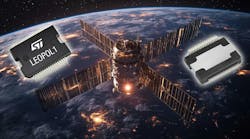Superjunction 600-V MOSFETs Optimized for AI and Telecom Servers
WeEn Semiconductors’ WSJ2M60R065DTL, a 600-V superjunction MOSFET, was developed specifically for computing and telecom server applications. It combines high operating voltage, efficient operating characteristics, and an advanced thermal design to address the demands of artificial intelligence (AI) and other high-performance processing applications.
Based on the company’s latest generation superjunction technology, the MOSFET combines an industry-leading on-resistance (RDS(on)) and figure of merit (RDS(on) × Qg) with an ultra-compact TOLL package. It’s rated for 50 A, features a maximum RDS(on) of 65 mΩ, and maintains a typical blocking voltage of around 700 V.
The MOSFET also has an integrated and fine-tuned forward recovery diode (FRD), which ensures excellent reverse-recovery robustness and balanced high-temperature performance. The body diode can withstand a commutation speed of 1000 A/μs without damage. This makes it particularly suitable for zero-voltage-switching (ZVS) applications in soft-switching topologies, where it can deliver high efficiency while handling irregular operating conditions.
At the same time, stable resistance performance delivers a steady and predictable RDS(on) across a range of current and temperature conditions.
Click here for more information about WeEn Semiconductors’ product portfolio.
Next in This Edition of PowerBites
More PowerBites
About the Author
Lee Goldberg
Contributing Editor
Lee Goldberg is a self-identified “Recovering Engineer,” Maker/Hacker, Green-Tech Maven, Aviator, Gadfly, and Geek Dad. He spent the first 18 years of his career helping design microprocessors, embedded systems, renewable energy applications, and the occasional interplanetary spacecraft. After trading his ‘scope and soldering iron for a keyboard and a second career as a tech journalist, he’s spent the next two decades at several print and online engineering publications.
Lee’s current focus is power electronics, especially the technologies involved with energy efficiency, energy management, and renewable energy. This dovetails with his coverage of sustainable technologies and various environmental and social issues within the engineering community that he began in 1996. Lee also covers 3D printers, open-source hardware, and other Maker/Hacker technologies.
Lee holds a BSEE in Electrical Engineering from Thomas Edison College, and participated in a colloquium on technology, society, and the environment at Goddard College’s Institute for Social Ecology. His book, “Green Electronics/Green Bottom Line - A Commonsense Guide To Environmentally Responsible Engineering and Management,” was published by Newnes Press.
Lee, his wife Catherine, and his daughter Anwyn currently reside in the outskirts of Princeton N.J., where they masquerade as a typical suburban family.
Lee also writes the regular PowerBites series.





